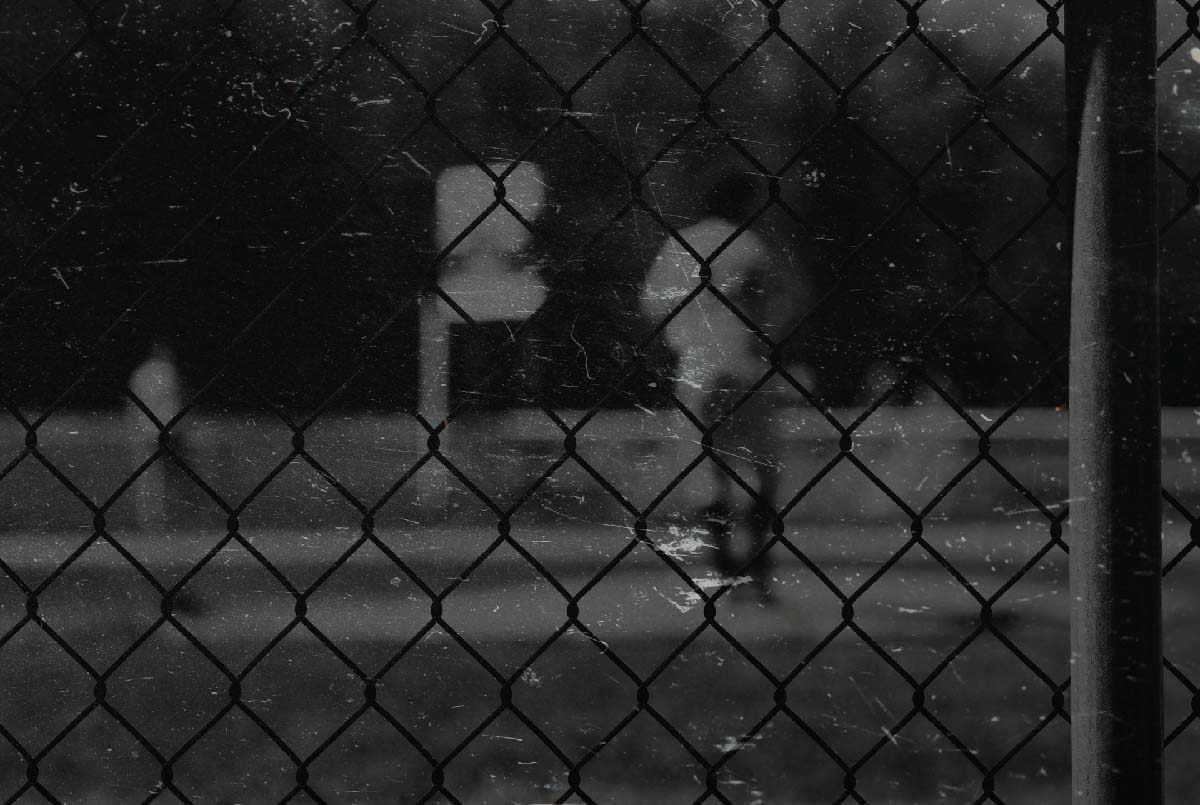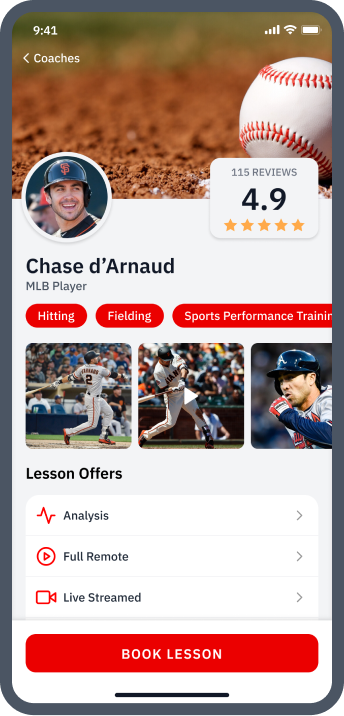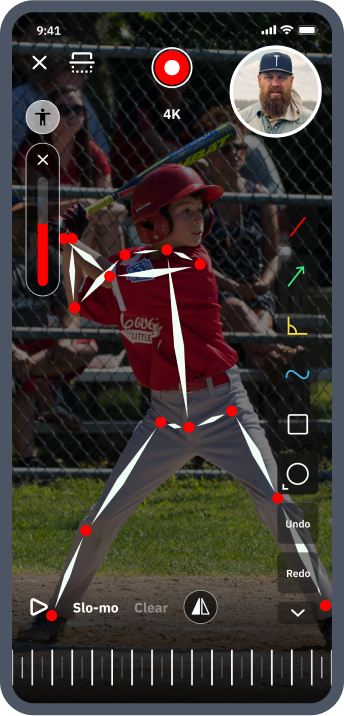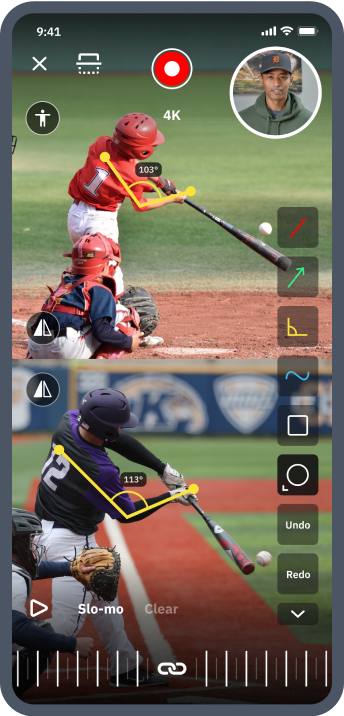Does Grip Strength Really Matter for Baseball & Softball Hitters? | Science Check

Traditionally, grip-enhancing exercises were a major part of nearly every serious baseball and softball training regime.
Generations of ballplayers had at least one coach who pushed us to squeeze tennis balls, roll small weights strung to broomsticks up and down, and do forearm curls everyday if we wanted to improve our game.
Today, grip strength is a hotly debated topic in high-level baseball and softball circles.
Tons of scientific research has now gone into measuring and evaluating its role in performance across many athletic endeavors.
And experts have forwarded that grip might not be as critical to our games as we intuitively thought it was.
In this comprehensive guide to all things grip strength, we’ll equip you with all of the facts so you can decide for yourself if it matters for baseball and softball hitters.
We cover:
- What is grip strength?
- Grip strength in other health contexts
- Three types of grip
- Studies on grip strength
- Do baseball and softball players need grip strength training?
But If you’re pressed for time, the TL;DR answer to whether or not grip strength matters for ballplayers is:
Training specific to your grip is largely a waste with no real impact on a baseball or softball athlete’s in-game performance. Ballplayers’ time and energy is much better spent on the timing and mechanics of their swings, coupled with the compound movements of a total body strength training program.

What is Grip Strength?
Grip strength is how firmly you can grasp or hold onto things and how heavy the things you’re gripping can be.
With a weak grip, you can struggle to hold things tightly, or you can only grip something lightweight.
Measuring grip strength is a common assessment tool in sports like baseball, softball, tennis, golf, or weightlifting. Medicinal science has also shown it to be a quality of life indicator for elderly adults.

How is grip strength measured?
Your grip is measured in pounds using a tool called a dynamometer.
One of the most common brands is the Jamar Hand Dynamometer, which tests grip in five different hand positions.
As you squeeze the handle, the machine measures the amount of force you’re applying to it.

Your grip is the weakest in two positions: when your fingers are spread the farthest apart and when your fingers are closest to your thumb. Your average score is usually taken from position two, the second smallest grip.
This is according to the National Institute for Health Research, which also advises using their grip strength testing protocol to get the most accuracy possible:
- The athlete sits in a chair with a 90 degree bend in their elbow.
- Next, the athlete gets a full grip of the dynamometer with the gauge or digital display facing out to the coach.
- Then, the coach pushes the athlete to "squeeze, squeeze, squeeze," in order to ensure that athlete showcases every ounce of power they’ve got.
- The coach can then share the results and log it, before turning the needle back to zero or resetting the digital display.
- Then, of course, the coach and athlete do the same thing to test the other hand.
- Coaches should give athletes three attempts on each hand, then tally the average for the athlete’s right and left side.
This video from the Department of Exercise Science at the University of Delaware demonstrates how to use a dynamometer:
What’s a normal grip strength?
Your grip strength metrics will depend on your age, sex, and which hand you’re measuring.
Your dominant hand will usually be stronger than your non-dominant one.
We say “usually,” because for some baseball and softball athletes this isn’t the case.
When hitting, the non-dominant hand is often on the bottom. When someone both throws and bats right-handed, for example, their left hand will be gripping on bottom when they hit.
Because the bottom hand is so important to pulling through a swing, after thousands of hours of batting practice, it’s not completely uncommon for high school, college, and professional level hitters to have developed stronger grips with their non-dominant hand.
In 1985, researchers developed norms for grip strength, based on an adult’s age and sex.
The categories were broken up into five-year blocks, ranging from age 20 to 74, male and female.
Data shows that grip strength peaks between ages 25 and 39 for most men and women.
For women in this peak age range, the grip strength for the right hand hovers around 60 pounds and for the left hand it averages out around 50.
For men, the right hand is closer to 98 pounds, and the left hand around 80.
But if you’re a baseball or softball parent or coach, you’re probably more interested in grip strength norms for 3 to 17 year old boys and girls.
And we won’t leave you hanging.
Here are the results below from a 2017 cross-sectional research study on youth and adolescent grips strength from the National Institutes of Health Toolbox project.
Pay close attention to the highlighted dominant hand and non-dominant hand grip strength “Means'' for boys and girls. These represent the averages found in the study’s data.
And if you need to convert those kilograms to pounds, you can do it here.

What is Grip Strength used for?
Being able to securely grasp, lift, and carry things is important for everyday life.
Someone with a very weak grip will struggle through tasks and might even be at risk for other health problems.
- Medicine – Grip strength is used to help diagnose diseases, evaluate treatments, and for recovery and rehabilitation.
Grip strength is also an indicator of mental state and of overall body strength in older adults.
Some research has even shown grip strength as a predictor for mortality, linking it to cardiovascular disease.
The relation between heart health and grip strength might seem tenuous, but it’s been pointed out that someone with less overall strength in their muscles will have a harder time recovering from the effects of systemic disease. - Sports – Grip strength as a measure for athletic performance and training has become a popular notion in the last few decades.
Handgrip strength supposedly measures one’s readiness for sports, as it helps contribute to overall speed and precision in sports.
But we’ll get into much more detail on grip strength and sports in the following sections. We promise. - Contests – In addition to its applications in medicine and sports, grip strength has become a popular feat for competitive contests all over the world.
These events will use one-arm deadlift, nail bending, closing spring hand grippers, and standardized pinch apparatuses to test grip strength amongst the participants.
The Three Types of Grip
Grip strength can be categorized into three different types:
- Crushing
- Supporting
- Pinching.
Each is necessary for certain tasks, and depending on the sport or position you play, one might be more important than the others.
Crush grip
Crush grip measures how tightly you can squeeze an object between your fingers and your palm, your extrinsic muscles.
This type of grip is used for shaking hands, climbing ropes, holding a heavy dumbbell, or swinging a bat.
Studies about grip strength and hitting mostly have to do with crush grip.
When you “crush” something, you’re activating the muscles in your forearms as well as your hands.
Some exercises that strengthen crush grip are the hand clench, grip clench, towel wring, towel rows, and towel pull-ups.
Support grip
A support grip is similar to a crush grip, but it instead deals with duration.
It’s the ability to hold on to something or hang from an object for an extended period of time.
Everyday tasks like carrying bags of groceries or baskets of laundry require support grip.
Support grip is even less relevant to baseball and softball because there’s no movement in the sports that requires holding on to or hanging from an object for a long time.
But, support grip does contribute to overall handgrip strength.
The dead hang, farmer’s carry, and bucket carry exercises can all help with support grip.
Wanna grow your baseball or softball coaching brand?
Get connected to new local and online lesson clients—along with all the tools you need to scale.
Download the free app

Pinch grip
Pinch grip has to do with the strength of your fingers, or intrinsic muscles. You need pinch grip to open jar lids, throw objects, or rock climb.
In a blog post for SimpliFaster, Bob Alejo uses evidence from engineering and ergonomic journals to support a claim for the importance of finger training in overall grip.
One study showed how the fingers alone can contribute between 18 and 30 percent of force to a person’s grip.
Another study that Alejo cited demonstrated what many clinicians already know about grip strength – the smallest (most tightly closed) and largest (most open) grips are the weakest.
The sweet spot is somewhere in the middle, with fingers spread a little but not too much.
In baseball or softball, pinch grip might be more applicable to pitchers and catchers than to other players.
Pitchers’ fingers apply varying amounts of pressure to the ball to create movement on pitches. Catchers use pinch grip when they squeeze the ball in their glove and frame pitches.
Exercises like the plate pinch and pinch grip transfer can help with this aspect of gripping.

Grip Strength for Other Health Effects
As researchers delved more into grip strength, they found that it’s related to several aspects of health.
As part of the Prospective Urban and Rural Epidemiological (PURE) study, grip strength was measured in 140,000 adults in 17 countries over four years.
It was one of the largest studies to date that has tested grip strength and showed significant links between grip strength and overall health.
Every 11-pound decrease in grip throughout the study showed:
- A 16 percent higher risk of dying from any cause
- A 17 percent higher risk of dying from heart disease
- A 9 percent higher risk of stroke
- A 7 percent higher risk of heart attack
Even after controlling for factors that contribute to heart disease, like age, smoking, and exercise, the connections between grip strength and cardiovascular disease were strong.
The large PURE study also reinforced previous notions that grip strength is an indicator for biological age.
As a marker for overall muscle strength, grip strength can be used to predict health problems later on.
Interestingly, the PURE study didn’t show a correlation between grip and type 2 diabetes, cancer, or other chronic diseases.
The authors of the study suggested that grip strength predicts mortality instead because greater muscle strength contributes to general survival.
If you think about all the possible survival or injury scenarios that having good grip strength might help, like stopping a slip or fall inside one’s home, you’ll realize how much sense this hypothesis makes.
Other studies have also shown that grip strength is an explanator in older adults for the following:
- Upper limb function
- Bone mineral density
- Fractures
- Falls
- Malnutrition
- Cognitive impairment
- Depression
- Sleep problems
- Multimorbidity
Grip strength clearly has a role to play in overall health.
But what about in baseball and softball, we hear you asking – screaming?

Studies on Grip Strength in Baseball and Softball
The baseball swing has fascinated sports scientists and movement experts for decades.
Researchers have delved into the kinematics of swinging a bat, the effects of small muscle activity while swinging a bat, and the effects of strength training on hitting performances.
These studies evaluated what effect, if any, the hands, wrists, and forearms have on the baseball or softball swing.
In 1961, Donald E. Race conducted a mechanical analysis of the movements involved in hitting a baseball, one of the first studies to do so.
His study, along with subsequent ones that assessed kinetic data and wrist movement in a baseball swing, showed that wrist actions are not significantly important to swing mechanics.
In 1987, Dr. Robert Adair of Yale University prepared a report for the President of the National League on the mechanics of baseball.
In discussing the swing, Adair said that the arms and hands mainly serve to transfer the kinetic energy generated by the hips, that their contribution to the energy of the bat is almost negligible.
Meaning the arms and hand do almost nothing and all along for the ride generated by lower half.
Electromyography (EMG) is used to study muscle activity. Since 1964, at least four studies have used EMG to evaluate muscle activity during a batter’s swing.
The conclusions these studies came to were:
- Hitters can increase the force they transfer to the bat by strengthening their lead triceps brachii muscles
- The abdominal muscles play a pivotal role in trunk stabilization
- Swinging a weighted bat on deck doesn’t give any advantage to the hitter
- The baseball swing is a sequence of coordinated muscle activity, starting in the legs
Historically, research on the baseball swing has shown that the hands and wrist don’t contribute much to increased bat velocity and force. Rather, they continue the chain of transfer energy from the lower part of the body.
These studies would seem to suggest that grip strength is unimportant in hitting.
Despite this, David J. Szymanski et al. demonstrated in two separate studies here and here that grip strength was at least statistically significant with bat-end speed and batted-ball exit speed in adolescent, high-school, and college athletes.
Other studies around the same time had shown that total-body strength training naturally improved forearm and grip strength as an auxiliary effect.
As a result, it’s been recommended that total-body weight training was the best approach, as opposed to isolated grip training, if players want to increase bat velocity, center of percussion velocity, or hand velocity.
Finally, as a rebuttal to David J. Szymanski et al. and previous work on the topic, in an extensive full review of handgrip strength in sport, John Cronin et al. concluded that for stick, club, bat, racket, and ball sports – like baseball and softball – the timing and sequencing of the force applied matters more than the magnitude of the force alone.
This same massive review also concluded that grip strength as a standalone variable wasn’t significant enough to make a difference one way or the other.
This study and others like it seem to be in consensus that grip is not a critical factor when it comes to the baseball or softball swing.

Do Baseball and Softball Players Need Grip Strength Training?
Should baseball and softball players be concerned with grip strength?
With scores of anecdotal evidence from players and coaches advocating grip strength training on the one hand, and a large body of research demonstrating that it’s not that significant on the other, making this call comes down to weighing long held beliefs and intuition against scientifically demonstrable facts.
We tend to favor the latter here. But let’s dive in a bit deeper.
Does forearm training increase bat velocity?
Baseball and softball coaches have traditionally focused on grip strength because the notion that strong wrists and hands lead to a quicker, more powerful swing makes intuitive sense.
As we saw with the several studies cited above, this thinking is flawed.
That doesn’t mean that grip strength doesn’t matter at all for bat velocity, though. If the swing is a kinetic chain, as many researchers have dubbed it, then every part of the chain needs to at least function properly for maximum performance.
Basically, you can't have a broken link in the chain.
Driveline Baseball compares the kinetic chain and grip strength to a car engine.
The “engine” for hitters is the legs and core, but the smaller muscles serve to “stabilize the bat and transfer power down the barrel of the bat as well.”
They do similarly conclude, however, that training specific to your grip is largely a waste of time.
In a 2004 study on grip strength and bat velocity, Shawn S. Hughes et al. tested the bat velocity of 23 collegiate baseball players as they underwent forearm and grip strengthening exercises.
The study lasted six weeks, with one group doing extra grip and forearm resistance training and a control group doing regular total body workouts.
Their results showed that both groups’ bat velocity improved over the course of the study, but that there wasn’t a statistically significant link between grip strength and bat speed.

Is isolated grip training bad for you?
With the incidence of things like Tommy John surgery on the rise among 15 to 19-year old baseball players, some coaches wonder if too much emphasis is placed on sport-specific strength training and conditioning in the modern game.
A recent study among high-school baseball pitchers showed that grip strength might in fact influence elbow conditions. These correlations were made based on self-administered questionnaires and our focus in how hitting at the moment.
But, we have written extensively on youth baseball pitching injuries and arm care.
Okay, getting back to isolated grip training.
In an article for Stack, coach Tony Bonvechio explains why such supplemental forearm and grip strengthening exercises are unnecessary for most ballplayers.
He elaborates on crush and pinch grip, saying that by throwing a ball and swinging a bat, players are already doing grip training all the time.
If you’re playing baseball or softball on a regular basis, you’re probably doing enough to strengthen your grip – extra training would be overkill and potentially detrimental.
Bonvechio also argues that players are doing the wrong exercises to improve grip strength and forearm muscles in the first place.
By training incorrectly, they’re putting even more stress on their elbows.
Instead of wrist curls and wrist extensions, athletes who do wish to train their grip and forearms should try supination (turning the palm up), pronation (turning the palm down), and ulnar deviation (spreading your little finger) exercises.
And rather than curling and extending dumbbells with a closed hand, players can do finger extensions with a rubber band.
Finally, instead of doing so many exercises that require gripping weights, athletes can try swapping in hands-free lift variations or med ball work.
Try these exercises instead of wrist curls if you do insist on training grip.
Final Thoughts on If Grip Strength Really Matters for Baseball & Softball Hitters
So, does grip strength matter for baseball and softball hitters?
To a very small extent, yes. But it’s not so important that players should focus on improving grip strength exclusively.
Grip strength is a useful measure for overall health and muscle strength, especially for older adults. And strong hands and wrists are essential for carrying out everyday tasks, and those with abnormally weak grips who struggle with daily tasks should likely work on their grip strength.
In strength training for baseball and softball athletes, however, grip strength training shouldn’t take precedence over total-body training.
Furthermore, any grip exercises your athletes do decide to try should focus on the fingers and not on the forearms.
The moral of this story, like so many others when it comes to baseball and softball performance, is that heavy skill work on the field and in batting cages coupled with compound lifting programs is where ballplayers should put their focus.
Unlock your ballplayer’s full potential
Find the perfect vetted coach to build a solid foundation or take your player's skills to new heights.
Download the free app

About the Authors
Dr. Edgar Rodriguez DC, CCSP.
Founder of EROD Sports Medicine & Training
Doctor Edgar Rodriguez DC, CCSP, is recognized as a leader in both sports chiropractic and performance fields. He's currently an adjunct professor at the University of La Verne.
Courtney Withrow
Professional Writer
Originally from the U.S., Courtney is a Brussels-based freelance writer with a Master’s degree in International Relations. She grew up playing softball and still loves the game.

